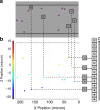Widely accessible method for 3D microflow mapping at high spatial and temporal resolutions
- PMID: 35782292
- PMCID: PMC9246883
- DOI: 10.1038/s41378-022-00404-z
Widely accessible method for 3D microflow mapping at high spatial and temporal resolutions
Abstract
Advances in microfluidic technologies rely on engineered 3D flow patterns to manipulate samples at the microscale. However, current methods for mapping flows only provide limited 3D and temporal resolutions or require highly specialized optical set-ups. Here, we present a simple defocusing approach based on brightfield microscopy and open-source software to map micro-flows in 3D at high spatial and temporal resolution. Our workflow is both integrated in ImageJ and modular. We track seed particles in 2D before classifying their Z-position using a reference library. We compare the performance of a traditional cross-correlation method and a deep learning model in performing the classification step. We validate our method on three highly relevant microfluidic examples: a channel step expansion and displacement structures as single-phase flow examples, and droplet microfluidics as a two-phase flow example. First, we elucidate how displacement structures efficiently shift large particles across streamlines. Second, we reveal novel recirculation structures and folding patterns in the internal flow of microfluidic droplets. Our simple and widely accessible brightfield technique generates high-resolution flow maps and it will address the increasing demand for controlling fluids at the microscale by supporting the efficient design of novel microfluidic structures.
Keywords: Applied optics; Engineering.
© The Author(s) 2022.
Conflict of interest statement
Competing interestsThe authors declare no competing interests.
Figures








References
-
- Poelma C, Vennemann P, Lindken R, Westerweel J. In vivo blood flow and wall shear stress measurements in the vitelline network. Exp. Fluids. 2008;45:703–713. doi: 10.1007/s00348-008-0476-6. - DOI
-
- Bown MR, Meinhart CD. AC electroosmotic flow in a DNA concentrator. Microfluidics Nanofluidics. 2006;2:513–523. doi: 10.1007/s10404-006-0097-4. - DOI
-
- Koutsiaris AristotleG, Microscope DSMaST. PIV for velocity-field measurement of particle suspensions flowing inside glass capillaries. Meas. Sci. Technol. 1999;10:1037–1046. doi: 10.1088/0957-0233/10/11/311. - DOI
-
- Oishi M, Kinoshita H, Fujii T, Oshima M. Simultaneous measurement of internal and surrounding flows of a moving droplet using multicolour confocal micro-particle image velocimetry (micro-PIV) Meas. Sci. Technol. 2011;22:105401. doi: 10.1088/0957-0233/22/10/105401. - DOI
LinkOut - more resources
Full Text Sources
